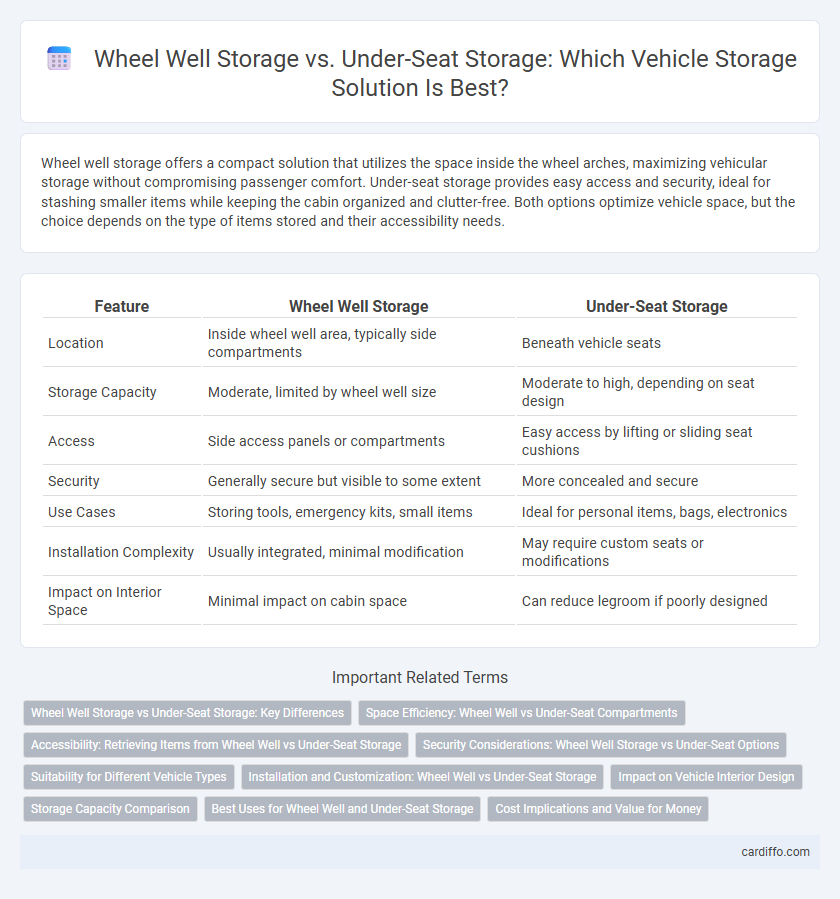Wheel well storage offers a compact solution that utilizes the space inside the wheel arches, maximizing vehicular storage without compromising passenger comfort. Under-seat storage provides easy access and security, ideal for stashing smaller items while keeping the cabin organized and clutter-free. Both options optimize vehicle space, but the choice depends on the type of items stored and their accessibility needs.
Table of Comparison
| Feature | Wheel Well Storage | Under-Seat Storage |
|---|---|---|
| Location | Inside wheel well area, typically side compartments | Beneath vehicle seats |
| Storage Capacity | Moderate, limited by wheel well size | Moderate to high, depending on seat design |
| Access | Side access panels or compartments | Easy access by lifting or sliding seat cushions |
| Security | Generally secure but visible to some extent | More concealed and secure |
| Use Cases | Storing tools, emergency kits, small items | Ideal for personal items, bags, electronics |
| Installation Complexity | Usually integrated, minimal modification | May require custom seats or modifications |
| Impact on Interior Space | Minimal impact on cabin space | Can reduce legroom if poorly designed |
Wheel Well Storage vs Under-Seat Storage: Key Differences
Wheel well storage utilizes the space above the vehicle's wheels, offering compact compartments that do not intrude into passenger legroom, making it ideal for storing smaller items securely. Under-seat storage, located beneath the seats, provides larger, often more accessible space for bulkier belongings while maintaining easy reach for passengers. The key difference lies in spatial optimization--wheel well storage maximizes typically unused cavities with limited capacity, whereas under-seat storage balances volume and convenience for everyday items.
Space Efficiency: Wheel Well vs Under-Seat Compartments
Wheel well storage maximizes vertical space by utilizing the area around the vehicle's wheels, offering deeper compartments ideal for bulky items but limiting horizontal expansion. Under-seat storage provides a flatter, more accessible space optimized for organizing smaller, frequently used objects without compromising passenger legroom. Comparing both, wheel well compartments excel in handling larger, irregularly shaped gear, while under-seat storage enhances overall space efficiency by integrating seamlessly into cabin design.
Accessibility: Retrieving Items from Wheel Well vs Under-Seat Storage
Wheel well storage offers quick and easy accessibility since items are located at the vehicle's side, allowing for swift retrieval without bending or kneeling. Under-seat storage requires reaching beneath seats, which can be less convenient and may involve more effort, especially in tight or cramped spaces. For frequent access to smaller or essential items, wheel well storage provides superior ease compared to under-seat compartments.
Security Considerations: Wheel Well Storage vs Under-Seat Options
Wheel well storage offers enhanced security due to its typically enclosed and less accessible position, reducing the risk of theft or tampering compared to under-seat storage, which is more exposed and easier to reach. Under-seat storage compartments may lack robust locking mechanisms, making wheel well storage preferable for valuable or sensitive items. Choosing wheel well storage enhances protection by minimizing exposure and increasing concealment within vehicle design.
Suitability for Different Vehicle Types
Wheel well storage offers practical space-saving solutions ideal for trucks and SUVs with pronounced wheel arches, maximizing cargo capacity without compromising interior room. Under-seat storage is better suited to sedans and compact cars, providing discreet compartments that utilize otherwise wasted space beneath seats for smaller items. Each storage type enhances vehicle organization by adapting to the specific interior layouts and space constraints of different vehicle categories.
Installation and Customization: Wheel Well vs Under-Seat Storage
Wheel well storage offers straightforward installation, often requiring minimal modifications to existing vehicle structures, making it ideal for quick customization. Under-seat storage requires more precise fitting and potential adjustments to seat mounts or frames, providing a more integrated but complex setup. Customization options for under-seat storage typically include modular compartments and locking mechanisms, while wheel well storage focuses more on maximizing space efficiency through tailored inserts.
Impact on Vehicle Interior Design
Wheel well storage shapes vehicle interior design by creating dedicated compartments that protrude into the cabin space, often altering floor contours and limiting flat floor areas for passenger comfort and cargo flexibility. Under-seat storage maximizes space utilization without compromising floor levels, enabling a cleaner, more spacious cabin layout that supports ergonomic seating arrangements and increased legroom. Choosing between wheel well and under-seat storage impacts overall interior design by balancing storage capacity with passenger comfort and aesthetic integration.
Storage Capacity Comparison
Wheel well storage offers increased capacity by utilizing the space around the wheel arches, often providing larger and deeper compartments than typical under-seat storage. Under-seat storage is generally shallower and constrained by seat structure, limiting its volume but offering easy access and secure containment for smaller items. Comparing both, wheel well storage maximizes available vehicle space for bulkier gear, while under-seat storage excels in convenience for everyday essentials.
Best Uses for Wheel Well and Under-Seat Storage
Wheel well storage is best suited for maximizing space in vehicles by utilizing the often-overlooked area above the wheel arches, ideal for storing tools, emergency kits, or compact gear without sacrificing main cabin space. Under-seat storage is optimal for keeping frequently accessed items such as personal belongings, small bags, or electronic devices securely tucked away but easily reachable during travel. Both storage solutions enhance vehicle organization by efficiently utilizing otherwise unused space while catering to different accessibility and item size needs.
Cost Implications and Value for Money
Wheel well storage often incurs higher manufacturing costs due to customized interior molding and reduced usable space, making it less cost-effective compared to under-seat storage. Under-seat storage maximizes space utilization with minimal alteration to vehicle design, delivering better value for money by enhancing functionality without significantly increasing production expenses. Consumers seeking affordable, practical storage solutions typically benefit more from under-seat compartments in terms of cost efficiency and overall utility.
wheel well storage vs under-seat storage Infographic

 cardiffo.com
cardiffo.com